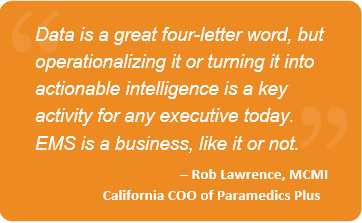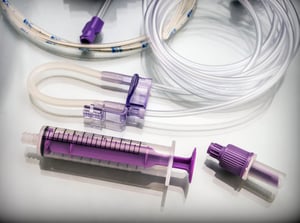Chart Smarter: Why One EMS Agency Ditched Paper for Mobile Tech
The Most Important Metrics Your Agency Should Be Measuring
“Data is a great four-letter word, but operationalizing it or turning it into actionable intelligence is a key activity for any executive today
Was this information valuable?

“Data is a great four-letter word, but operationalizing it or turning it into actionable intelligence is a key activity for any executive today. EMS is a business, like it or not.”
– Rob Lawrence, MCMI California COO of Paramedics Plus
In today’s data-driven world, healthcare providers are tasked with measuring criteria to objectively quantify their performance across the operational, clinical and financial realms. Emergency medical services are no exception.
To ensure your agency is performing at a consistently high level, measurement and reporting of key clinical performance indicators are essential. But what specific indicators should EMS agencies track?

CHEST PAIN/STEMI CARE
By measuring the data on SEMI Care, you can identify your team’s strengths and weaknesses. When you know where there’s room for improvement you can change tack, whether it’s introducing a software solution or a new protocol.
Regardless, you should be measuring:
- Time from 9-1-1 access to CPR
- Administration of aspirin
- Was a 12-lead ECG completed and transmitted?
- Direct transport to appropriate facility with communication to activate cardiac team/ECG-to-balloon times (on-scene time less than 10 minutes)
According to the 2018 EMS Trend Report, “27 percent [of respondents] weren’t sure if their organization tracks cardiac arrest data, which is a potential indication that systems either aren’t measuring performance or are not adequately sharing the numbers with the providers performing resuscitations. Sharing and explaining results with the providers is essential to improving system performance.”
RESPIRATORY DISTRESS
Diligence in tracking these two KPIs when it comes to respiratory distress can help you make tough decisions in future, faster. Memory is faulty, data is fact. It will help you and your team’s performance to be monitoring these:
- Administration of nitroglycerin (without contraindications)
- Prehospital noninvasive positive pressure ventilation rates
 INTUBATION
INTUBATION
Although first pass success is frequently promoted as the goal of emergency intubation, not much published evidence existed until the journal of Academic Emergency Medicine published a study in January 2013 confirming a direct correlation between increased incidences of adverse events and number of attempts at intubation.
With these science-backed findings, we can confidently recommend that you measure:
- First-pass success rates on endotracheal intubation
- Capnography waveform measurement with every patient that requires an emergent airway
IV INSERTION
There are so many variables that effect whether or not a paramedic is able to successfully insert an IV on the first go. Knowing what your organization’s first attempt success rates are and what methodology they’re using can give you a starting point to understanding how your team is performing. From there you can help those who need it improve their performance with additional training and achieve greater consistency across your organization.

STROKE
Combining EMS and hospital data allows for deeper insights into how well the services provided by both ultimately benefited the patient. By tracking the following metrics, your organization can not only see how it’s handling stroke patients, but can go on to participate in a national registry like “Get with the Guidelines - Stroke,” allowing you to see how your performance compares to others.
Make sure you’re measuring:
- Time of symptom onset to arrival at stroke receiving center
- Was a prehospital stroke alert conducted?
- Was the patient admitted?
TRAUMA
For trauma, it is mainly important that you are measuring Immediate and direct transport time to designated trauma center (on-scene time less than 10 minutes).
HOSPITAL ADMISSIONS
Recent data shows that it continues to be difficult for EMS systems to obtain information on patient outcomes. Of the 1259 EMS professionals who took part in the EMS Trend Report’s survey, only 42 percent said their organizations track patient survival to discharge. This information is an important learning tool for EMS providers to be able to inform their first impression with the hospital’s diagnosis.
Your organization should be tracking:
- Was the patient admitted to the hospital?
- If so, what was the patient’s length of stay?
- On discharge, was the patient deceased, discharged to home, to a skilled nursing facility, or another medical facility?
GENERAL CLINICAL
Last but certainly not least:
- Does your agency use the regional EMS council clinical protocols?
- Do you calculate a REMS score for each patient?
Using the EMS council clinical protocols will help your organization adopt a more standardized approach to the practice of patient care and to stay current with new prehospital clinical care guidelines as they are introduced and developed. From there, you can plan for how to roll out new protocols within your agency.
Measuring the REMS score allows you to measure the impact EMS is having on patients' conditions, treatments and outcomes.
As Jamie Chebra, Director of Emergency Medical Services at JFK Medical Center said in a EMS1 article on Embracing the data revolution, "REMS by prehospital providers can add quantifiable data that can help answer the fundamental question that will define our profession: 'Does EMS make a difference?'”
Sources:
The Importance of First Pass Success When Performing Orotracheal Intubation in the Emergency Department: https://onlinelibrary.wiley.com/doi/full/10.1111/acem.12055
Related Posts
The End of Delayed Documentation
4 Must-have Data Points for Dispatch-Billing Alignment and Maximum Reimbursement
ZOLL Pulse Blog
Subscribe to our blog and receive quality content that makes your job as an EMS & fire, hospital, or AR professional easier.
ZOLL Pulse Blog
Subscribe to our blog and receive quality content that makes your job as an EMS, fire, hospital, or AR professional easier.





